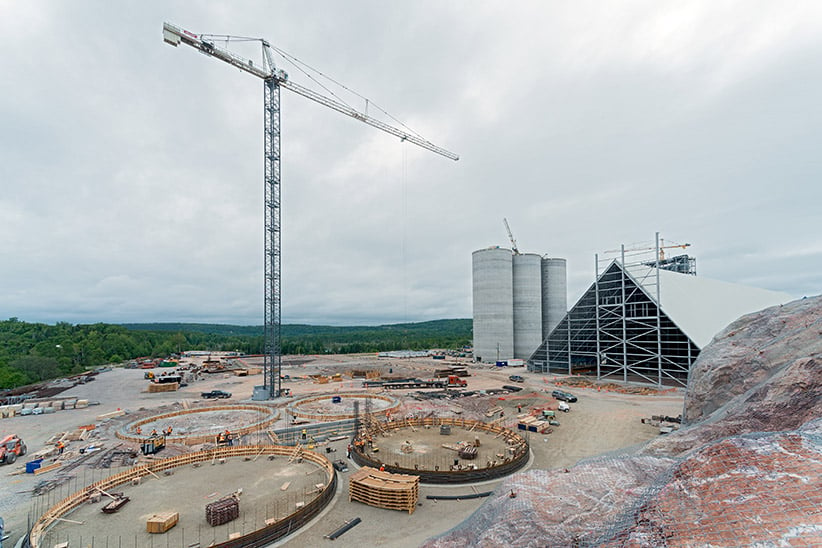In Quebec, a cement factory encased in hypocrisy
Why did the Quebec government hand millions to an emission-belching, billionaire-owned cement factory?
Construction of the McInnis cement factory in Gaspe. (Jacques Gratton)
Share

Cement is created by crushing together calcium-rich rock, typically limestone, with clay and sand, then heating the mixture to nearly 2,000° C.
Critics say the political process by which Quebec’s $1-billion Port-Daniel–Gascons cement plant came to fruition is nearly as straightforward. The provincial government issued a $250-million loan and invested $100 million, then sidestepped its own environmental regulations in order to hang on to a key riding in a far-flung region—and curry favour with Laurent Beaudoin, the scion of the Bombardier clan, one of Quebec’s most politically influential families. (La Caisse de dépôt, the province’s public pension fund manager, also invested $100 million.)
Whether it is an astute public investment or the product of political favouritism, this much is true: the plant, which is located on the southern flank of Quebec’s Gaspé Peninsula, will emit between 1.8 and 2.2 million tonnes of greenhouse gases a year after it starts up this fall. This will make it the largest emitter of carbon in the province, according to Canada’s environment ministry, and will dwarf the yearly emissions of Shell Canada’s oil sands operations in Fort McMurray, Alta.
It will also rival, if not exceed, the emissions associated with the Energy East pipeline project, which Quebec has opposed on environmental grounds. According to figures in a report prepared for the Ontario Energy Board, the planned pipeline that would transport bitumen eastward from Alberta will generate somewhere between 0.7 and 4.3 million tonnes of extra carbon a year, depending on increases in production. At the very least, the cement plant will generate the equivalent of roughly half those emissions from a single location—without an environmental assessment.
What’s more, Quebec’s economic ministry recently acknowledged that the project had cost overruns of nearly $450 million, without having produced a single tonne of cement.
Though Quebec economic minister Dominique Anglade recently expressed her frustration at the overruns, she said the project would be “profitable” because of a low Canadian dollar and an increase in construction in the United States, where the plant will export the vast majority of its product.
Others disagree. “I think it’s an open question as to whether [the plant] will be financially viable,” says Colin Sutherland, president of SC Market Analytics, a cement market forecasting firm. “People in the industry don’t think they’re going to sell as much as they need to sell to be profitable.”

If there is a cautionary tale in government forays into the Gaspé economy, it is the barren field on the outskirts of the town of Chandler, roughly 40 km northeast of Port-Daniel. Until 2007, when it was sold to a Vietnamese company, this site was home to Gaspésia, a paper mill that was the source for upwards of 700 direct and indirect local jobs in the region.
Hampered by high costs and outdated technology, the plant couldn’t compete amidst a downturn in demand and a glut of supply. The Quebec government invested some $465 million in the plant, all for naught. In 2004, faced with cost overruns of $200 million, the plant powered down. It shut its doors permanently three years later.
Like Gaspésia, the first promoters of the Port-Daniel cement factory touted the region’s bountiful natural resources (limestone is in great supply), a ready workforce and proximity to the U.S. market. In 1995, businessman Guy Rousseau proposed a plant that could produce just over one million tonnes of cement a year, nearly all of which would be put on container ships and carted to voracious American markets on the eastern seaboard.
Rousseau’s company, Cimbec, couldn’t secure funding, and the project lay dormant until 2011, when Cimbec was purchased by Beaudier Group, the investment arm of the Beaudoin family. The new company, baptized McInnis after a prominent local family, would develop the mothballed project. And it would have help.
As the corporate stewards of rail and aeronautics giant Bombardier, the Beaudoin name looms large on Quebec Inc.’s horizon. A staunch if discrete federalist, Laurent Beaudoin has found favour from governments on either side of the province’s federalist–nationalist divide—much more so than the Desmarais family, Quebec’s other billionaire-business clan, which had little regard for anything associated with the Parti Québécois.
Such favour was on display on Jan. 31, 2014, when Péquiste premier Pauline Marois announced her government’s $450-million investment in the project. “The people of Bonaventure [the riding where the plant is located] made an excellent choice last election, and today you have the results of that choice,” Marois said at a press conference, prompting a chuckle from Beaudoin, who was sitting beside her.
The project announced that day would be double the size of the 1995 version. Despite this, and despite the nearly 20 years that passed between the old project and its larger offspring, the new project wasn’t submitted to an environmental review process, which includes public hearings.
The governmental logic was that the original project was proposed in 1995, months before Quebec adopted far stricter environmental standards for new projects. Therefore, it should be held to those 1995 standards. “If a new cement plant project was submitted to Quebec’s environment ministry, it would be subjected to an evaluation process and an examination of the environmental impacts. This would include public hearings,” says Geneviève Lebel, of Quebec’s environment ministry, adding, “Port Daniel isn’t subject to this process.”
As it happens, TransCanada’s* pipeline project is subject to such an environmental review. Hearings wrapped up last spring, and the Quebec government is expected to produce a report on the project in November, about the same time the cement plant is scheduled to begin production.

Though the PQ retained the riding of Bonaventure, Marois and the party lost the election a few months after the McInnis announcement. Among the first orders of business for the incoming Liberal government, apart from changing the name of its environment ministry to include the words “fight against climate change,” was to maintain its support of Port-Daniel, which will be the largest producer of greenhouse gases in the province’s history.
Even former critics have come around. A few weeks after Marois announced the government support of Port-Daniel, Coalition Avenir Québec MNA Christian Dubé denounced the PQ for “trying to win elections” with $450 million in public funds. Dubé left the CAQ the following August to become vice-president of the Caisse de dépôt, which put him in charge of overseeing the Caisse’s Port-Daniel investment. He has since been decidedly less critical of the cement plant.
“Dubé still thinks the project was political from the start. Now that he’s seen the numbers, though, he believes it is economically sound,” a Caisse source told Maclean’s. (Dubé didn’t respond to an interview request.)
Along with a low Canadian dollar, the viability of the plant will depend on the health of the U.S. market. It has been a bumpy ride. The U.S. consumed 131 million tonnes of cement in the pre-crash days of 2006, according to the U.S. Geological Survey. It reached a low of 69 million tonnes in 2010, and has since recovered slightly, to 93 million tonnes in 2015—about what it was in 1995, when the plant was first proposed.
“Port-Daniel’s success lies in the American market—if the dollar continues to be low, if it is able to produce on time at volume, and if it is able to compete with Europe and Asia. There are a lot of ifs there,” says Sutherland. The Portland Cement Association, which represents American cement manufacturers, recently downgraded its 2016 growth forecasts from five per cent to 3.4 per cent. It has also trimmed its 2017 forecasts from 5.7 per cent to 4.3.
In 2014, Sutherland and his partner, David Chereb, produced a report on the status of the industry in northeast Canada and United States. Even without Port-Daniel’s estimated 2.2 million tonnes of concrete, “demand is for the most part exceeded by the current supply,” the report read.
Quebec producers were outraged the new plant got the go-ahead from the province. Swiss-based LafargeHolcim, which has holdings in the province, sued McInnis in an attempt to quash the Quebec government’s authorization of the plant. The suit has pitted the Beaudoins against the Desmarais family, whose Power Corporation owns a minority stake in Lafarge.
Though it is ongoing, the suit won’t likely halt Port-Daniel’s production of cement this fall. Despite nearly half a billion dollars in public funding, Port-Daniel’s viability remains up in the air—like so much carbon dioxide.
CORRECTION, Aug. 6, 2016: This story originally claimed that Enbridge is the proponent of the Energy East pipeline project. In fact, that proposal is a TransCanada project.